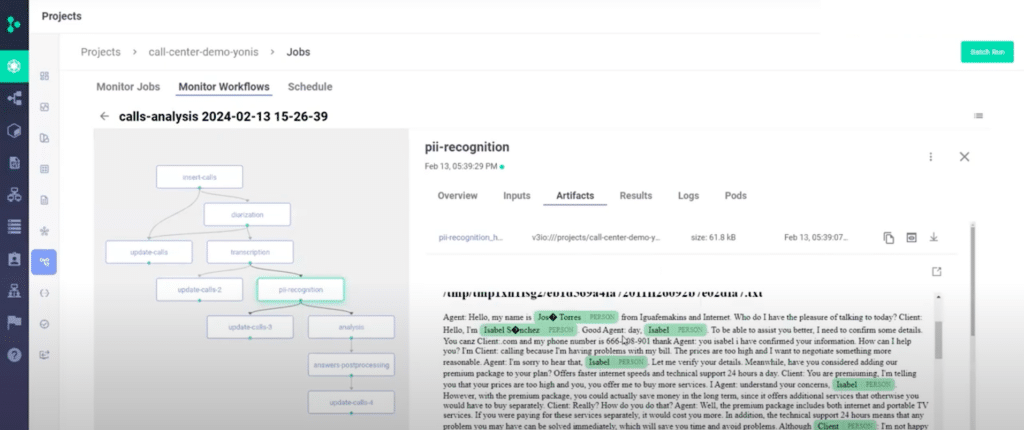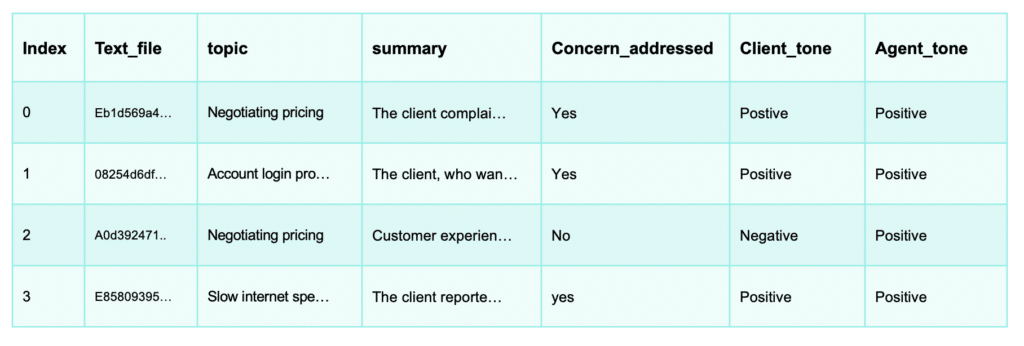Generative AI in Call Centers: How to Transform and Scale Superior Customer Experience
Alexandra Quinn and Guy Lecker | March 31, 2024
Customer care organizations are facing the disruptions of an AI-enabled future, and gen AI is already impacting customer care organizations across use cases like agent co-pilots, summarizing calls and deriving insights, creating chatbots and more. In this blog post, we dive deep into these use cases and their business and operational impact. Then we show a demo of a call center app based on gen AI that you can follow along.
For more details on this topic, you can watch the webinar this blog post is based on. Oana Cheta, Partner and Lead Gen AI Service Ops for North America at McKinsey & Company and Yaron Haviv, Co-Founder and CTO of Iguazio (acquired by McKinsey), share insights, examples and more details. Watch here.
The 3 Driving Forces of AI Impact
AI is broadly redefining work and the economy. The three main areas of impact are:
1. Dramatic productivity gains in how companies are run. This includes improving functions like coding, customer interactions, creative work and content synthesis.
2. Transformation of products to change how customer needs are met. This includes new enhanced features, like conversational interfaces, co-pilots and hyper-personalization.
3. A redistribution of profit pools through a new layer of AIaaS in the value chain. This could enable solutions like ChatGPT that replace entire value chains, low-cost native AI startups that quickly create new solutions at low costs and simplified onboarding and migration processes between products.
How Are Industries Being Transformed with Gen AI?
As a result, entire industries could shift from productivity-focused applications to end-to-end domain capabilities. For example:
Customer engagement
- Current capabilities: Call center coaching and chatbots
- Future capabilities: New segments and leads identification with coordinated outreach campaigns
Marketing
- Current capabilities: Creative content generation
- Future capabilities: "Segments of one" with hyper-personalized products and services
Data, analytics and software engineering
- Current capabilities: Coding copilots and assistants
- Future capabilities: Automated code generation and end-to-end unassisted mainframe migration
Finance
- Current capabilities: Business document generation
- Future capabilities: Market intelligence and synthesis and M&A target identification and strategy
Talent and organization
- Current capabilities: HR support and automation
- Future capabilities: Personalized workforce training and upskilling programs
Let’s dive into customer care use cases.
The State of Gen AI in Customer Care
AI interactions are expected to constitute 30%-50% of customer care interactions in the next five years. This will include more voice-to-voice interactions and a consolidation of channels, like IVR, chats, visual assistant and others, into a channel-agnostic AI solution.
Currently, forward-thinking customer care companies are prioritizing four main themes:
- Reprioritization of core operations, while prioritizing operational excellence, customer satisfaction and revenue generation.
- Creating an AI ecosystem that is future-ready by prioritizing technology as one of the top three strategic goals, while striving to have all customer interactions handled by AI.
- Reimagining the service network with innovation hubs by working with vendors that provide innovative capabilities and switching towards results-driven contracts.
- Investing in employee excellence, capability building and upskilling as a key to organizational success.
How Will Gen AI Impact Customer Care?
The impact of Generative AI across the customer care funnel is especially notable across the following touchpoints:
- Demand Reduction - Eliminating service demand for up to 10%-25% through proactive digital engagement or improved analytics to solve root causes. This is done through enhanced speech analytics capabilities, interaction simulations, proactive resolution suggestions and more.
- Deflection to Unassisted - Making unassisted digital channels more human-like to maximize containment. This can be done through virtual assistants, voice-to- voice IVA experiences, or real-time translation, for example.
- Assisted Routing Optimization
- Vendor Optimization
- Assisted Operational Efficiency
- Service Optimization - These capabilities are enabled by tapping into new data sources and optimizing existing data sources and leveraging actionable insights.
What are Some Customer Care Use Cases for Gen AI?
Gen AI can be of special assistance in the following customer care use cases:
1. Enhanced back-office automation - Automatically interpreting and prepopulating memos and client docs, like income statements.
2. Post-conversation insights - Summarizing speech to text in a few succinct points to create a record of customer complaints, actions taken and recommended steps based on company policies.
3. Knowledge base search - Enhancing service agents’ capabilities by providing real-time ChatGPT-style access to all relevant information, including product guides, policies and call transcripts.
4. Live agent co-pilot - Providing real-time assistance and suggestions for responses using customer history, product/contract details. This also helps with agent ramp-up.
5. Chatbot - Creating an empathetic chatbot experience to replace lower-value agents.
3 Differentiation Categories of Gen AI in Customer Care
Gen AI features and capabilities for customer care can be divided into three categories of impact and differentiation that they provide the business:
1. Table Stakes - The emerging GenAl features across common service platforms. These include capabilities like after call insights, tracking repeat call frequency, service knowledge assistant and generating dynamic knowledge articles.
2. Innovative - The transformative GenAl functionality that creates value multipliers across the service funnel. These include capabilities like recommending products based on customer preferences, servicing co-pilot, a personal coach for agents that automates call summaries and assessments, and workforce management.
3. Distinctive - Novel capabilities that leverage complex data orchestration and advanced engineering. These include training simulations, a virtual agent, service digital twins for surveys and routing calls based on agent skills.
The ROI of an Integrated Servicing Agent Copilot
Prior to deploying Gen AI, customer care organizations have had to deal with lengthy agent ramp-ups, complex organizational knowledge and customer-agent experiences that are difficult to standardize.
With an agent copilot, the burden and risk is decreased for agents, resulting in:
- Reduced customer chat costs by up to 25%
- Reduced average handling time by up to 40% on complex trouble-shooting calls
- 3x faster agent ramp-up 3X
It’s important to note that AI is not a one-time deployment. Instead, it needs to maintain a collaboration with the business. Impact will be achieved by orchestrating these capabilities.
What are Some AI Pitfalls to Avoid?
Gen AI can drive significant innovation, productivity and create new value. Yet, leaders must be diligent to not repeat pitfalls experienced by other companies:
- Neglecting to define a value roadmap
- Surrendering to technology and/or operating debt
- Forgetting the human experience element
- Challenges with scaling Al from pilot to production
- Lack of Al Maturity/Governance
- Lack of quantifiable operational outcomes
How to Build a Gen AI Application for Customer Care
Now, let’s dive into a demo of a customer care application based on gen AI. The demo is based on MLRun, an open source MLOps orchestration framework. You can clone the Git and follow the Notebook.
The Notebook is divided into two elements: generating fake calls, if you don’t have your own data, and a pipeline for data analysis.
The pipeline comprises a number of steps:
- Inserting calls
- Diarization
- Breaking the audio to segments
- Transcription
- Updating the database
- PII recognition
- Filtering
- Analysis
- Post-processing
Most of these functions are library functions, which don’t require writing code. Instead, you can build a pipeline, provide arguments for each step and run the pipeline with MLRun. The pipeline uses MLRun’s Function Hub.
Some examples of the steps in the pipeline:
For PII recognition and masking, the pipeline leverages a function from the Hub to identify sensitive entities in the text and anonymizes them based on the component policy:

In the analysis phase, the pipeline generates a table with the call summary, its main topic, customer tone, upselling attempts and more:

Post-processing involves cleaning, anti-hallucination and other actions to make the output usable. In this case, being empathetic and kind is paramount:

The information is stored in a database with the calls. Selecting a call enables hearing it, reading the transcript, seeing the analysis, etc. Companies can also prompt the LLM to find a call based on a certain category. This database can then be used as a basis for new applications that deliver insights and smart actions.
Additional MLRun supported capabilities for customer care apps include:
- Transcribing the audio in real-time when the user or client is talking, for analysis. This is done with a batch pipeline. MLRun provides a code snippet that transcribes audio from an incoming stream in real-time and sends the text to a different application.
- Real-time co-pilot - When the client talks to the agent, a recommendation system suggests a script for the agent. Recommendations are based on knowledge about the company, the client, the products and more. With MLRun, questions are passed to a backend system that uses a RAG and an LLM to browse databases and documents and recommend next steps.
To see the demo and more details about gen AI for customer care, watch the webinar here.


